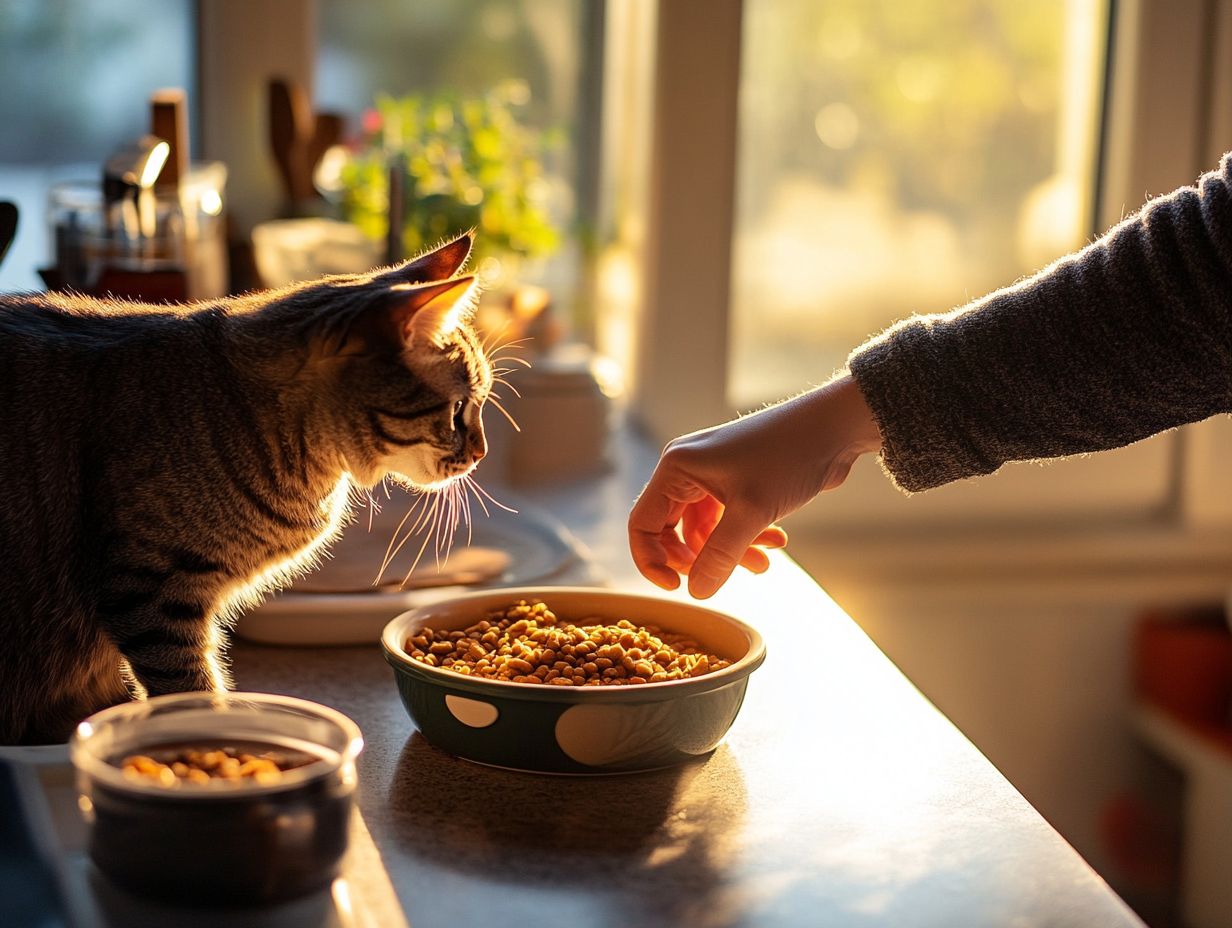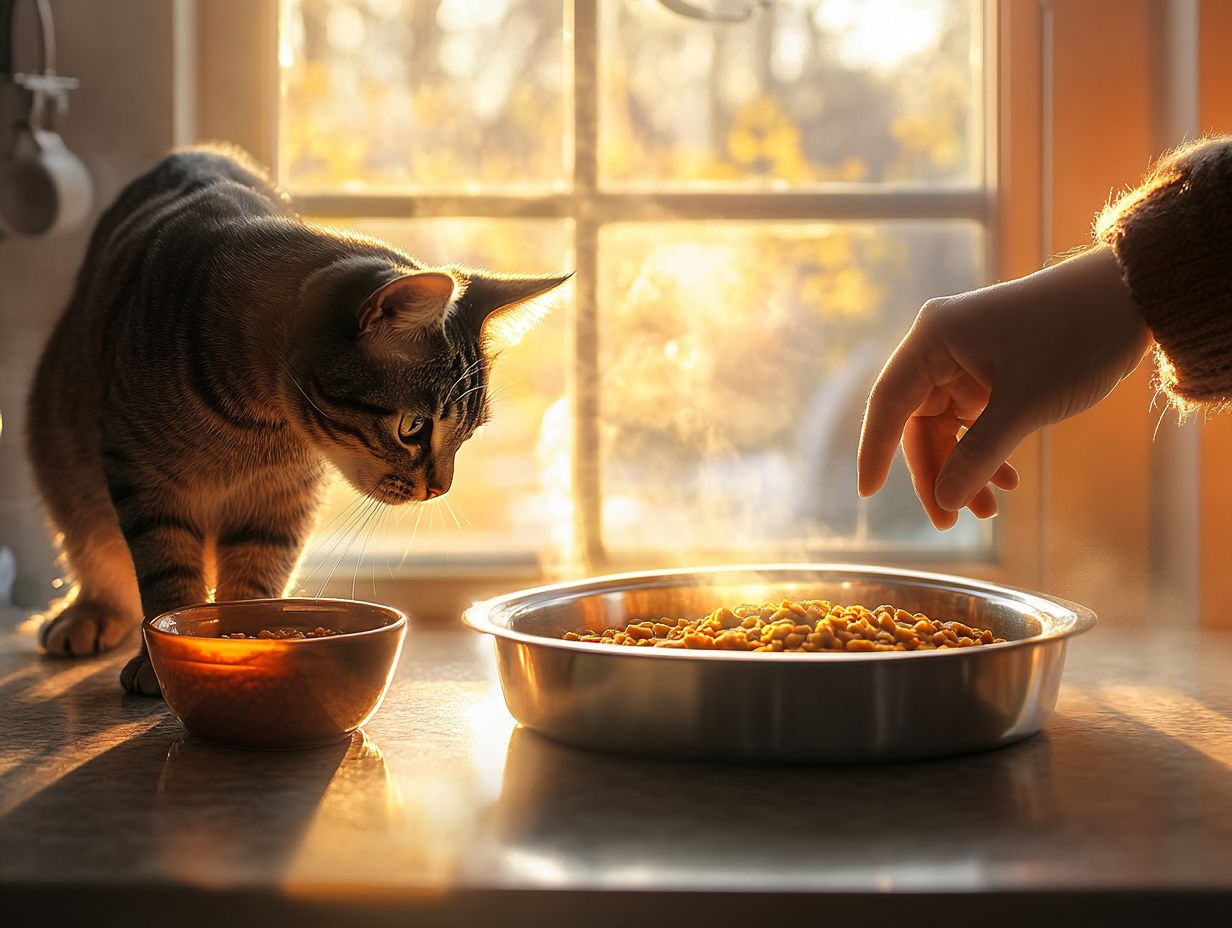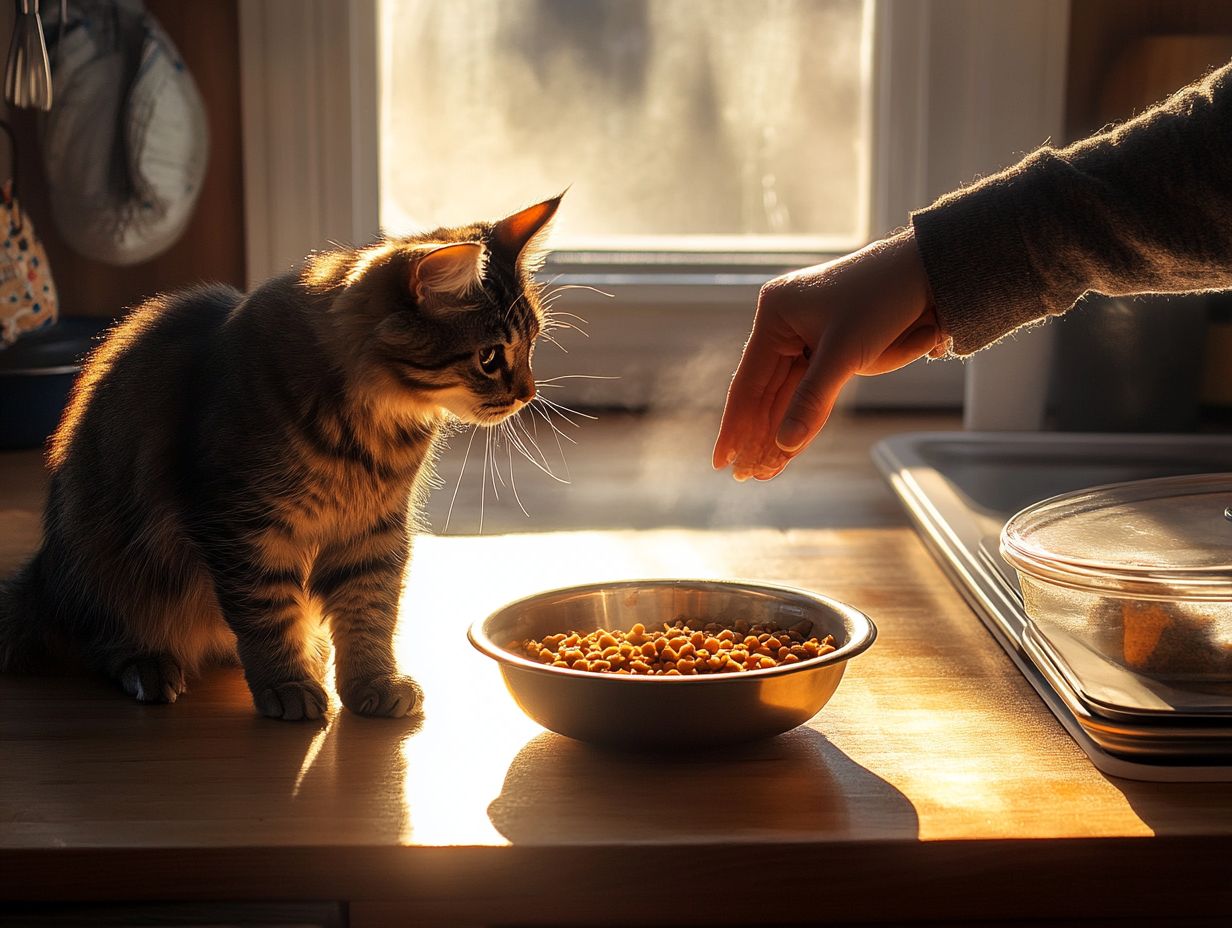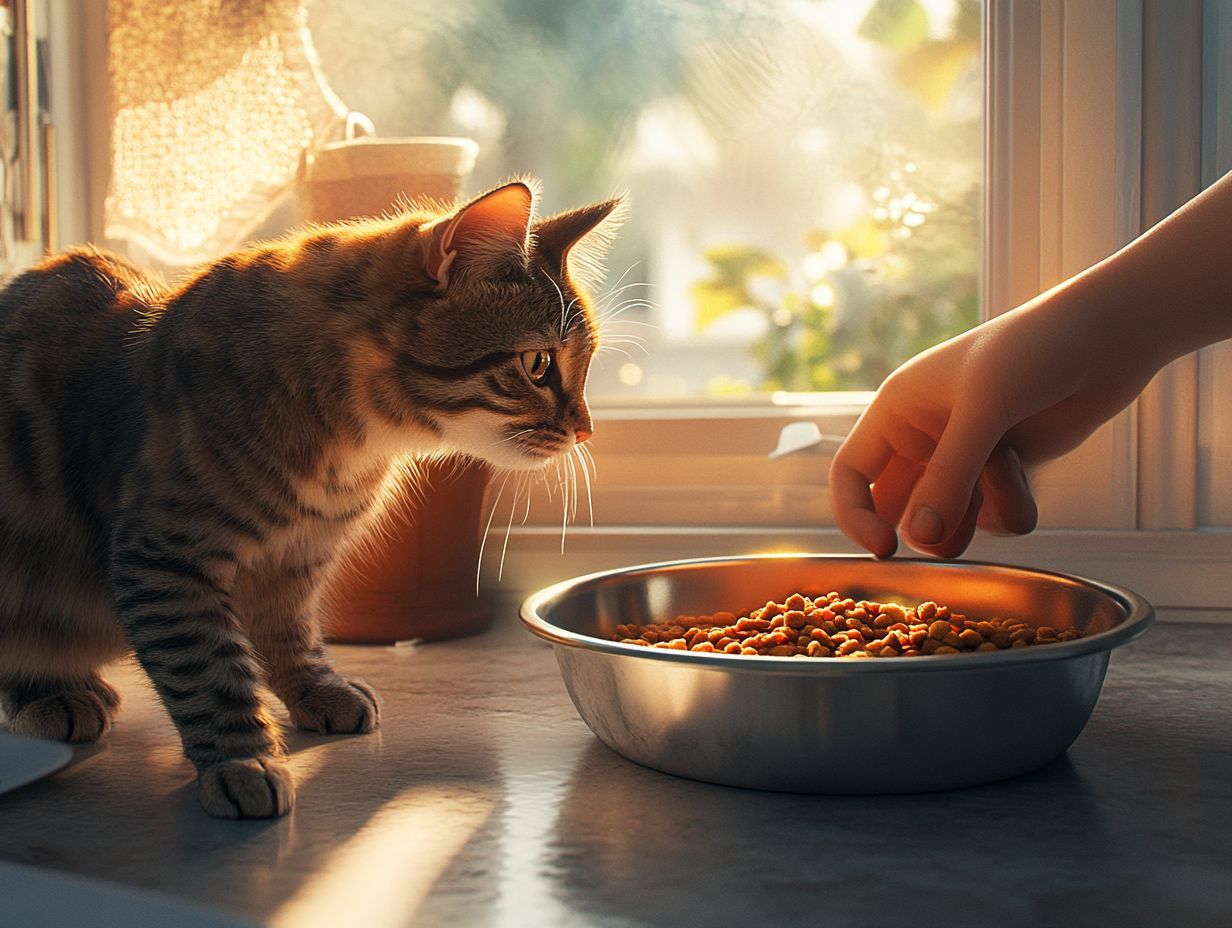Switching your cat’s food might seem daunting, but it can be a necessary step for their health, wallet, and convenience. Before making any changes, it’s crucial to consult with a veterinarian to ensure that the new diet aligns with your cat’s health needs and veterinary recommendations.
Whether you’re looking to improve your cat’s nutrition, save on costs, or make mealtime easier, understanding the right approach to cat diets, including high-protein options, is key. As obligate carnivores, cats require animal-source proteins to meet their dietary needs, making it essential to choose the right foods.
This guide will cover essential topics related to cat food:
- When and how to switch your cat’s food, considering dietary needs and food allergies
- What to expect during the transition
- Tips to ensure a smooth transition process
We will also highlight common mistakes to avoid, focusing on dental health and wellness, so you can keep your furry friend happy and healthy.
Dive in to learn everything you need for a successful food switch!
Key Takeaways:

Why Switch Your Cat’s Food?
Changing your cat’s food is a significant decision that can greatly impact their health and well-being, either positively or negatively. Cat owners may choose to change their pet’s food for various reasons, including health issues, cost considerations, or simply to enhance their cat’s enjoyment of mealtime.
It is essential to understand the benefits and drawbacks of different types of cat food, whether dry or wet, to ensure that your cat receives adequate nutrition and that their specific dietary needs are met. The process of transitioning to a new food is crucial for making informed medical, financial, and flavor-related decisions, considering food preferences and food texture.
1. Health Reasons
Poor nutrition can lead to various medical issues in cats, including obesity, diabetes, and kidney stones. However, health concerns are the most common reason for changing your cat’s food. When choosing between wet and dry food, consider that wet food contains higher moisture content, which is particularly important for kidney health, especially in senior cats or those with pre-existing conditions.
Selecting the right type of food, particularly high-protein diets, can significantly improve your pet’s overall health. These diets can help maintain a healthy weight and promote muscle development, which is especially important for overweight cats or those with specific metabolic disorders. Additionally, varying food types can enhance feline nutrition.
When transitioning to a new diet, it is crucial to carefully monitor your cat’s weight and eating habits. To minimize the risk of gastrointestinal distress, it is advisable to make the change gradually. Additionally, monitoring portion sizes and being aware of any changes in your cat’s energy levels or appetite will help ensure that the new food meets your pet’s specific medical needs.
It’s also important to recognize the risks associated with non-traditional diets (e.g., raw or vegan) and monitor for potential nutritional deficiencies, as these may not provide complete nutrition for obligate carnivores like cats.
2. Cost Savings
Transitioning to a new cat food can result in significant cost savings, especially when considering the benefits of reducing food waste and optimizing your cat’s meal schedule. By carefully selecting high-quality food that meets the nutritional needs of felines, owners can enhance their pet’s overall health while also minimizing the risk of health issues that often lead to costly veterinary visits.
A balanced diet, rich in essential nutrients and tailored to specific life stages or dietary requirements, is vital for boosting vitality and preventing ailments. Over time, investing in proper nutrition not only protects your furry friend from potential illnesses but also helps prevent unexpected vet bills from straining your budget.
Therefore, making informed decisions about what to feed your cat can genuinely transform both financial and health outcomes for pets and their owners alike.
3. Convenience
Changing your cat’s food can enhance convenience for cat owners, particularly in terms of feeding schedules and food consistency that aligns with their hydration needs. By experimenting with various feeding methods, such as high-quality wet food complemented by dry kibble for texture, or even using puzzle feeders, caregivers can address these concerns effectively.
Food Storage and Handling
Proper food storage and handling practices are crucial for maintaining feline health and preventing spoilage. Always store cat food in a cool, dry place and ensure that containers are sealed tightly to keep out moisture and pests.
Special Dietary Needs
Cats with conditions like kidney disease or diabetes may have specific dietary requirements. Consult with your veterinarian to determine appropriate nutrient profiles and formulation requirements to manage these conditions effectively.
It is essential to monitor your cat’s reactions to different meal types, as a flavor that seems appealing may not always encourage healthy eating behaviors. Making the right choice can improve feeding routines and reduce the stress associated with mealtimes, thereby ensuring balanced nutrition.
When to Switch Your Cat’s Food?
The timing for changing a cat’s food is crucial and depends on their individual needs, health issues, and any changes in their eating habits. It is important to carefully observe the signs that indicate when a cat’s food should be changed.
For instance, weight gain or loss may suggest that the current food is no longer suitable. Additionally, persistent vomiting or alterations in the frequency or consistency of bowel movements may indicate that a cat has developed food allergies or intolerances. Identifying the source of these issues is essential, as gastrointestinal sensitivities may necessitate a veterinary consultation.
A veterinarian can provide the most relevant advice for a specific situation, and any changes to a cat’s diet should address existing problems while ensuring they receive the best possible nutrition, particularly considering that cats are obligate carnivores and require animal-source proteins.
How to Switch Your Cat’s Food?
To prevent upset stomachs, it is important to gradually transition your cat to a new food. This is especially crucial for selective eaters or those with sensitive stomachs, as they may require a slower adjustment to their food intake, ensuring proper diet and minimizing food stress.
1. Gradual Transition

A gradual transition is essential when changing your cat’s food to minimize stress and reduce the likelihood of digestive issues. This allows your cat to adjust to new flavors and textures comfortably. Properly switching a cat’s food requires time and care; pet owners should aim to make the transition over a week or more, noting that some cats may require longer adjustments, especially those with health issues, while adjusting the feeding schedule to incorporate a mix of the old and new food, considering food changes and feeding tips.
Begin the process by adding a small amount of the new food to your cat’s current diet, gradually increasing the new food’s proportion each day. This slow addition is important as it gives your cat time to adjust their palate and digestive system. Furthermore, introducing a variety of food options can spark curiosity and encourage acceptance, making the transition smoother and more pleasant for both the pet and the owner.
2. Mixing Wet and Dry Food
Combining wet and dry food can enhance your cat’s eating experience, promote hydration, and offer a variety of food textures. This approach helps ensure that cats receive adequate hydration, which is crucial for their kidney health, by encouraging them to drink more water. This method also supports dental health by balancing different food consistencies.
Additionally, it stimulates their natural instincts by introducing different flavors and textures. Since cats can be selective eaters, a mixed diet may encourage healthy eating behaviors and encourage them to eat more.
This combination also facilitates a gradual transition when changing their diet, as they may be more willing to accept new wet food if it is paired with the familiar taste of dry kibble. Overall, this method supports a healthy eating pattern for your cat.
3. Adding Water to Dry Food
Increasing water intake by adding it to dry food can enhance your cat’s overall hydration and improve the texture of the food, making it more appealing to selective eaters during the transition. This addition not only boosts the flavor of the food but also helps ensure that proper hydration is incorporated into their diet.
Many cat owners may be unaware that cats often do not drink enough water, as their evolutionary history involved primarily consuming moisture-rich prey. Gradually increasing the water ratio in their food can facilitate the transition and maintain their interest in eating while ensuring they receive adequate hydration. Owners should ensure that the water added is clean and fresh, avoiding any toxic ingredients (like certain herbs or plants) around cats.
Additionally, placing extra water bowls around the house or providing a pet water fountain can encourage more frequent drinking and help establish healthier hydration habits, enhancing your cat’s wellness and overall pet health.
What to Expect During the Transition Period?
During the transition to a new cat food, it is important to closely monitor your cat, as changes in appetite, stool consistency, and behavior are common. Paying attention to weight monitoring is crucial during this period to ensure a successful food adjustment. If significant changes occur, such as persistent gastrointestinal sensitivities or signs of food allergies, consult your veterinarian for guidance.
1. Changes in Appetite
Changes in appetite are common during a food transition, so it is important for cat owners to monitor their pets’ food intake and preferences. Understanding the difference between a healthy adjustment and a concerning one can help ensure that their feline remains in optimal health. The recommended duration for a food transition is gradual, typically over 7-10 days, as abrupt changes can lead to gastrointestinal upset.
Owners should be attentive to signs that indicate whether their cat is simply adapting to a new diet or if there is an underlying issue that needs to be addressed. If your cat occasionally picks at their food or shows only sporadic interest, this may be a normal sign of adjustment. However, significant weight loss, lethargy, or a complete refusal to eat for more than a day may necessitate a visit to the veterinarian. For guidance on transitioning your cat’s food, check out this article on switching from wet to dry food.
To encourage your cat to eat during a food transition, consider the following strategies for a smooth transition:
- Mix the new food with their favorite treats,
- Heat the meal to enhance the aroma, and
- Provide smaller meals more frequently throughout the day.
2. Changes in Stool
Monitoring changes in your cat’s stool is crucial for assessing digestive health, especially during the food transition from their old food to new food. According to veterinary standards, healthy stool should be firm and well-formed, approximately the size of a toonie, light brown in color, and free of blood or mucous. Watery or excessively hard stools, abnormal colors, or the presence of blood can indicate underlying health issues.
During this transition process, your cat may experience diarrhea, constipation, or significant changes in stool frequency, all of which should be monitored closely. If the changes in their stool are significant and persist for more than a couple of days, it is essential to contact a veterinarian. They can evaluate the situation and determine whether a dietary adjustment or medical intervention is necessary.
3. Changes in Behavior
Monitoring changes in behavior is crucial for assessing how well your cat is adjusting to a new food, and it is essential for owners to remain vigilant during this period.
Observations can reveal whether your cat is eagerly eating the new kibble or avoiding it altogether. If you notice changes such as increased hiding or decreased playfulness, it may indicate that the new diet is causing some discomfort or unhappiness. Monitoring your cat’s eating habits can also provide insights into their flavor preference.
Additionally, cat owners should watch for signs of food stress around feeding times or unusual grooming patterns, as these behaviors may suggest that the transition has not gone as smoothly as expected. Always consult your veterinarian if you suspect potential food allergies, particularly to common allergens such as dairy, beef, or fish.
Expert Tips for a Smooth Transition

The best advice for ensuring a smooth transition when changing your cat’s food is to adhere to a strict feeding schedule and to closely monitor your cat’s health throughout the process, particularly their nutritional needs and food intake. Establishing a feeding schedule helps prevent obesity, aligning with current feline obesity guidelines.
1. Stick to a Schedule
Establishing a feeding schedule is crucial for a smooth transition, as it regulates your cat’s food intake and contributes to overall pet health. Providing consistent meal times helps pet owners create a routine that supports digestion and fosters healthy eating habits.
A feeding schedule allows your cat to anticipate when food will be available, reducing anxiety and encouraging more consistent eating. This approach is particularly beneficial during transition periods, as it helps your cat acclimate to different food types, textures, and food consistency.
Over time, a regular feeding schedule can assist in maintaining better weight control and energy levels, while also making it easier to detect changes in behavior or appetite—key indicators of your pet’s health.
2. Offer Variety
Offering a variety of animal-source proteins for your cat can keep them engaged and cater to their flavor preferences, particularly for picky eaters during transitions. Providing different proteins, such as chicken, turkey, or fish, can appeal to a cat’s natural instincts and dietary needs. Avoid plant-based food options, as cats are obligate carnivores and require animal protein for optimal health.
For cats with special dietary needs, such as those with kidney disease or diabetes, consult your veterinarian for tailored advice on suitable nutrient profiles. Always speak with a veterinarian before introducing any supplements or additives, as they can provide insight into the potential benefits and risks associated with common dietary supplements.
Finally, ensure proper food storage and handling; check for spoilage in wet and dry cat food, looking for off-smells or unusual textures. If you encounter issues during the transition, don’t hesitate to reach out to your veterinarian or adjust the transition process based on your cat’s response.
Additionally, diet variety between wet and dry foods can ensure a balanced meal plan that offers both hydration and dental benefits. Occasionally incorporating homemade treats, like cooked chicken or freeze-dried fish, should be done in moderation, ensuring that treats do not exceed 10% of their daily caloric intake to prevent nutritional imbalances. This can enhance their meals and stimulate their appetite, aiding in proper diet maintenance.
It’s important to monitor your cat’s health and track any changes in digestion or energy levels, adjusting their diet as needed to ensure they receive the necessary nutrition while enjoying a diverse menu. This will help in addressing potential sensitive stomach issues or food allergies.
3. Monitor Your Cat’s Health
During the transition period, closely monitoring your cat’s health for any medical issues and adjusting feeding habits as needed are crucial. Regular veterinary check-ups are essential to ensure your cat is thriving during this time and meeting all nutritional requirements. Selecting high-quality commercial diets that meet AAFCO standards is important to ensure complete and balanced nutrition, particularly when discussing food transitions.
A veterinary professional can assess your cat’s overall condition and health during these visits, providing insights that may not be evident in the home environment. Observing behaviors at home, such as appetite and activity levels, along with changes in litter box habits, can serve as important indicators of your cat’s health. For more information, learn how to switch your cat from wet to dry food, considering feline nutrition requirements.
A sudden loss of interest in food or a significant increase in sleep should always be taken seriously, as these changes may signal serious problems, such as medical conditions. Maintaining good communication with your veterinarian and being attentive to daily routines will help ensure your cat’s well-being.
Common Mistakes to Avoid
The most common mistakes made during a food transition for cats include switching foods too quickly and failing to monitor the cat’s health throughout the process. Food changes should be managed with care to prevent negative impacts on cat health.
1. Switching Too Quickly
One of the most common mistakes cat owners make is switching their cats’ food too quickly, which can lead to digestive upset and other health issues. When this happens, cats may experience symptoms such as vomiting, diarrhea, and loss of appetite, making the transition difficult for both the cats and their owners. It’s important to adjust food in gradual steps for a successful transition.
For instance, a sudden change in diet can disrupt the natural balance of gut bacteria, resulting in prolonged discomfort that could have been easily avoided. To prevent such unpleasant consequences, cat owners should gradually introduce new food over a period of seven to ten days, starting with ratios such as 25% new food to 75% old food for the first few days, to support adequate nutrition.
This approach allows pets to adjust more easily, ensuring a smoother transition while minimizing any potential digestive issues and helping to keep their cats happy and healthy. This gradual transition is key to maintaining proper diet.
2. Not Monitoring Your Cat’s Health
Failing to monitor your cat’s health during a food transition can result in missing signs of distress or adjustment issues; therefore, it is essential to be observant. Regular weight monitoring and tracking food habits are advised.
Appetite and stool quality are two major indicators of a pet’s well-being that should be closely monitored on a daily basis. Consider maintaining a daily journal to record eating habits and changes in litter box usage, allowing you to identify any concerning patterns related to dietary needs.
If you notice a significant drop in appetite, consistent vomiting, or unusual stools, these could be red flags that warrant a trip to the veterinarian as soon as possible. By identifying these changes early, cat owners can ensure their pets receive the necessary treatment in a timely manner. Additionally, this helps address potential medical issues promptly.
3. Not Consulting with a Veterinarian

Failing to consult a veterinarian before changing a cat’s food is a significant mistake that can overlook existing medical issues or special dietary needs. A veterinary consultation is essential to ensure that a cat’s specific nutritional requirements are met, especially if there are pre-existing medical conditions such as food allergies or obesity. For further reading on dietary needs and transitions for cats, consider visiting this resource.
Discussing these matters with a veterinarian can provide pet owners with personalized guidance that helps with both immediate dietary changes and the long-term health of the pet. It is crucial to base dietary changes on the health needs of the cat, as individual health requirements can vary widely and significantly impact their feline nutrition.
Guidance from a veterinarian can facilitate informed decisions, ultimately enhancing a cat’s quality of life and overall health by ensuring their dietary needs are met according to established guidelines, such as those from the Association of American Feed Control Officials (AAFCO).
Frequently Asked Questions
What are the benefits of switching my cat from wet to dry food?
Switching to dry food can help improve your cat’s dental health by reducing plaque and tartar build-up, as supported by recent veterinary studies. It can also be more cost-effective in the long run and may have a longer shelf life compared to wet food, reducing food wastage. However, it is essential to ensure adequate hydration to prevent urinary issues.
How do I know if my cat is ready to switch to dry food?
It’s important to consult with your veterinarian before making any changes to your cat’s diet. They can assess your cat’s overall health and determine if they are ready for the switch while discussing potential risks such as dehydration.
What is the best way to transition my cat to dry food?
The key to a successful transition is to do it gradually. Start by mixing a small amount of dry food into your cat’s wet food and gradually increase the proportion of dry food over the course of a few weeks. Monitor for any adverse reactions and consult your veterinarian if needed.
Are there any tips for encouraging my cat to eat dry food?
Some cats may be resistant to trying new food, so it’s important to make the transition as stress-free as possible. Mixing in a small amount of wet food with the dry food or adding a bit of warm water to soften the kibble can help, especially for picky eaters. This ensures they receive adequate nutrition.
How much dry food should I feed my cat?
The amount of dry food your cat needs depends on their age, weight, and activity level. Following AAFCO guidelines, a general guideline is to feed 1/4 to 1/3 cup of dry food per day for every 5 pounds of body weight. Consult with your veterinarian for specific recommendations tailored to your cat’s needs.
What if my cat refuses to eat dry food?
If your cat is still not interested in dry food after a few weeks of gradually transitioning, consult with your veterinarian. They may be able to recommend a different brand or type of dry food that may be more appealing to your cat, taking into account their food preferences and dietary needs.
What are the unique dietary needs for different life stages?
Kittens, senior cats, and pregnant or nursing cats have distinct nutritional requirements. Consult your veterinarian for guidance on appropriate foods and feeding strategies tailored to your cat’s life stage.
How should I store dry and wet food?
Store dry food in a cool, dry place and keep it sealed to prevent spoilage. Wet food should be refrigerated after opening and consumed within a few days. Always check for spoilage before feeding.
How can I manage my cat’s weight effectively?
Integrate weight management strategies into your cat’s diet, and monitor body condition scores regularly. Ensure that your cat receives a balanced diet that meets their energy needs while avoiding overfeeding.
Are dietary supplements necessary for my cat?
Consult your veterinarian to determine whether dietary supplements are appropriate for your cat. Discuss their necessity, safety, and appropriate dosages to ensure optimal health.